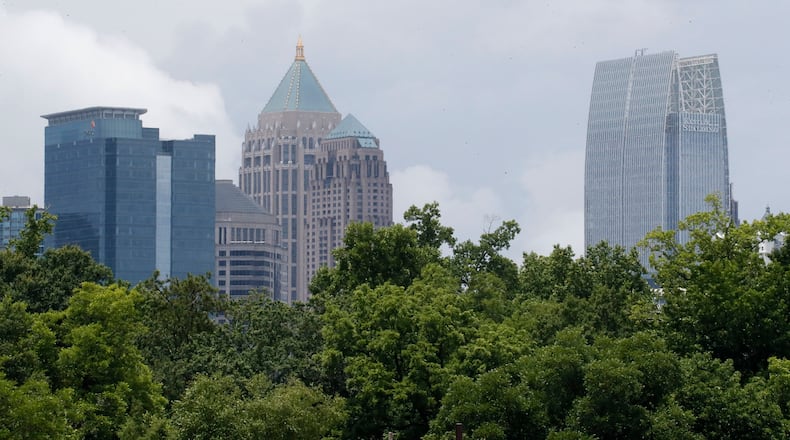After years of discussing, negotiating, arguing and even shouting, a new tree ordinance is coming into focus in the city of Atlanta.
Now comes the hard part, getting something passed that will satisfy both the tree-huggers and those who are tree cutters in the course of doing business.
And this is happening as the rate of trees getting cut down in Atlanta accelerates because homebuilding and remodeling remain healthy, even in a pandemic.
Chet Tisdale, a member of the Atlanta Tree Conservation Commission, which hears appeals when trees are cut down, says the city’s proposed ordinance falls woefully short of protecting trees. He said the proposal will allow homeowners and developers to remove up to 50% of the “priority” trees (the “good” ones — oaks, elms, maples, etc.) on small lots, even if they didn’t have to cut a single tree to build a home.
“This is not a tree-preservation standard. This is a tree-cutting standard,” said Tisdale, a retired lawyer who formed a group to come up with an alternative, more tree-friendly plan, one that the city is studying.
Worse, he said, the new ordinance would virtually eliminate residents’ right to appeal the cutting of trees in their neighborhood. He called it a “sweetener” to get developers to go along with it.
Credit: Courtesy of Chet Tisdale
Credit: Courtesy of Chet Tisdale
It’s been a tough stretch to be a stately oak in a town that likes to tout itself as “The City in a Forest.” In late 2019, I wrote a column about the city rolling out a version of a new tree ordinance. It went over so badly that city Councilman Matt Westmoreland had to apologize to the crowd, shut down the meeting, and cancel the next night’s hearing. Then, I’m told, he buried the plan under a rock.
At the time, I noted about 90,000 trees had been cut down in Atlanta in the previous six years. Since then, it has accelerated. In July through September of 2019, 4,319 trees were cut down. In the same period in 2020, 5,886 got chopped.
Why? Because the city of Atlanta is a popular destination despite the rise in violent crime and forces in Buckhead wanting to break away.
More often than not, there’s already a small house standing on the lot where someone wants to build their new, fancy abode. So after a bulldozer pushes down the house, the trees that had grown for decades near that home must be cut down to make way for the new structure — because the house to come is always much more grand than the house that’s now gone. (And to think, seven of us shared one bathroom growing up!)
The hope among tree advocates is that developers and builders get more creative about fitting new homes onto existing lots and leave the trees be. But scraping the lot and starting from a blank slate is just easier.
“I think some of the objections is builders’ perceived right to develop a lot like they want, where they can take a standard plan and fit the lot to the house, rather than fitting the house to the lot,” said Howard Katzman, a former builder who helped Tisdale craft the tree-protective counterproposal. “It’s human nature to take the easiest path.”
City planning czar Tim Keane, whose office is overseeing the effort to redraw the law, has found no easy path so far.
“This new ordinance is dramatically better than the one we have right now,” he said, mentioning that the current code basically makes builders pay to play by shelling out about $1,000 to cut down an oak that’s 30 inches in diameter at chest height.
Keane said the new ordinance will have what tree advocates and developers have long called for — a meeting between the city arborist and a builder before plans are drawn up. There, he said, they can hash out the site plans and potentially save some trees before a bunch of money has been spent to prep the construction site. What often happens is the building plans are lined up and work on the site starts. Then a neighbor sees a red “X” painted on a tree to be felled, and that neighbor files an appeal, shutting down the process.
Keane and Tisdale differ on how much power the city has to make builders try to save trees.
Keane said a meeting with the city arborist is required before anything can start. “We review (the plans), we expect you to save every priority tree you can, and the backstop is the most you can cut is 50% on the smallest lots,” he said. That percentage drops as the lots get bigger.
“If you write the regulations more strict, then we eliminate the right for anyone to appeal,” Keane said, adding it makes the process more certain, which builders appreciate. (Actually, next-door neighbors would be the only ones who can appeal.)
Still, Keane expects developers to push back on the plan.
Corey Deal, executive officer of the Greater Atlanta Home Builders Association, says it this way: “Does the tree own the lot?” He said the city should perform an economic analysis to see what the tree ordinance and an increase in “impact fees” for builders will cost.
Jim Cheeks has spent two decades mostly building in Atlanta. He said he is nervous because he works on a tight budget and has been building “affordable” homes, trying to keep them between $180,000 and $220,000, which is cheap for intown Atlanta. The cost will go up if it’s more difficult to cut trees, he said.
Areas on the south and west side, neighborhoods that haven’t seen much new construction in decades, would be the ones to suffer if a tree ordinance were too strict, making it more expensive to build, Cheeks said.
“The question should be improving the (tree) canopy as a whole, not individual trees,” he said.
He said there needs to be a better effort to get trees replanted after homes are built. Homes that were built decades ago were often carved out of forested lots. Those lots were replanted and are now graced by imposing trees. He pointed to the area of Glenwood Park, a subdivision built 10, 15 and 20 years ago in southeast Atlanta. Properties that saw trees planted then are now looking lush.
So, what does Cheeks say to a neighbor who sees the sky where grand trees used to be but were cut down to build a new home.
“Yeah, there’s really no retort,” he said. “But it’s probably what happened when your 80-year-old home was built.”
The saga continues before a City Council committee next month.
About the Author
Keep Reading
The Latest
Featured





